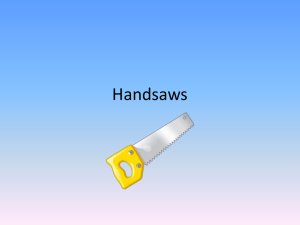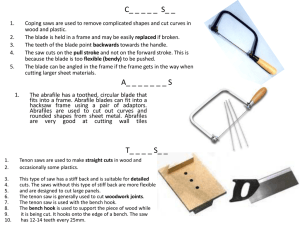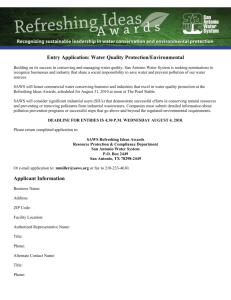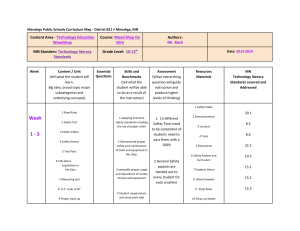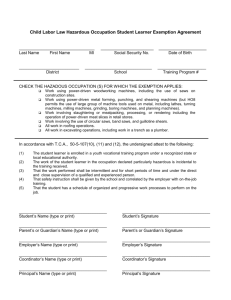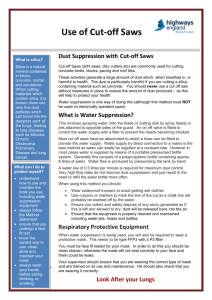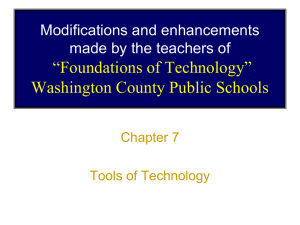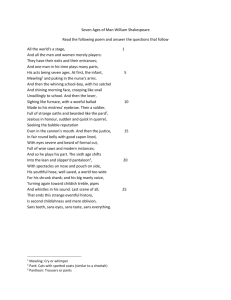Chapter 21 Woodworking Machinery
advertisement
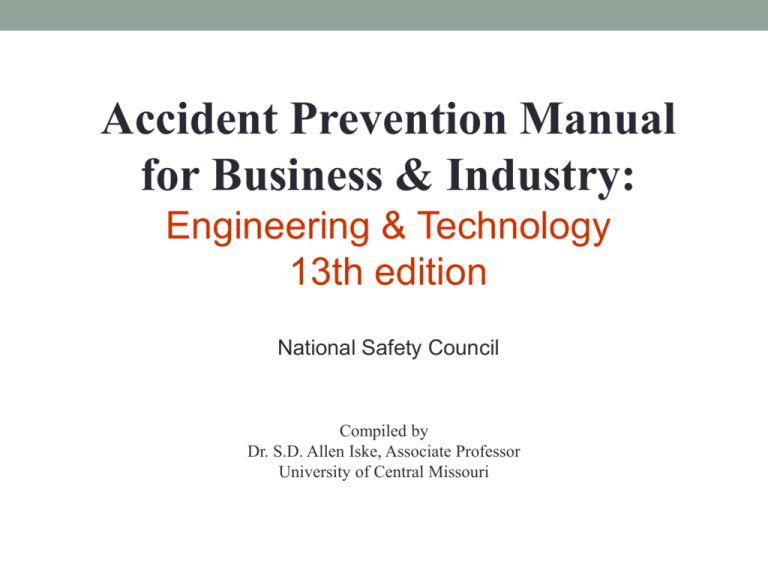
Accident Prevention Manual for Business & Industry: Engineering & Technology 13th edition National Safety Council Compiled by Dr. S.D. Allen Iske, Associate Professor University of Central Missouri CHAPTER 21 WOODWORKING MACHINERY General Safety Principles • Use equipment that meets OSHA, ANSI, and NFPA National Electrical Code standards. • Specify needs during purchasing. • Maintain all machines so that while they are running at full or idle speed and with the largest cutting tool attached, they are free of excessive noise and vibration. • Level all machines, including portable or mobile ones. • Secure machines to the floor or other foundations, when possible, to eliminate movement. General Safety Principles (Cont.) • Secure small units to benches or stands. • Make sure the machine is constructed so that tools that are too large cannot be mounted. • Ensure that all arbors and mandrels have firm and secure bearings and are free from slip or play. • Regularly check the adjustment of all safety devices. • Those involving electrical circuits should be actuated to make sure they operate properly. • Operators should lock out machines before cleaning, adjusting, or maintaining them. General Safety Principles (Cont.) • Keep loose clothing, long hair, jewelry, and gloves away from rotating parts of machinery. • especially from nips points and the point of operation • After the equipment has been completely stopped, clean work surfaces with a brush, not with the hand or a compressed air nozzle. • If possible, make adjustments only while the machine is not running. General Safety Principles (Cont.) • Electrical equipment • All metal framework on electrically driven machines should be grounded, including the motor. • Comply with NFPA 70, National Electric Code. • NFPA 70 includes the following provisions: • The machine shall have a cutoff devices (EMERGENCY STOP) within reach of the operator in the normal operating position. • Electrically driven equipment shall be controlled with a magnetic switch or other device that prevents automatic restart after power failure. General Safety Principles (Cont.) • Example of devices stopping restart General Safety Principles (Cont.) • Electrical equipment (cont.) • Position clearly marked power and operating controls within reach of the operator and away from hazards. • Protect operating controls against unexpected or accidental activation. • Provide a positive means (lockout) for rendering the controls inoperative in each machine operated by an electric motor. • If the machine does not have a power disconnect to lock it in the OFF position, unplug the cord and place a small padlock through the holes in the plug. • Install an electric motor break on machines that have excessive coasting time. General Safety Principles (Cont.) General Safety Principles (Cont.) • Guards • Enclose or guard all belts, shafts, gears, and other moving parts so no hazard is present for the operator. • Because most woodworking operations involve cutting, it is necessary, although often difficult, to provide guards at the point of operation. General Safety Principles (Cont.) • Guards (cont.) • Point-of-Operation Guards must: 1. be moveable to accommodate the wood. 2. balanced so as not to impede the operations. 3. strong enough to provide protection to the operator. • Whenever possible, completely cover blades and cutting edges at the point of operation. General Safety Principles (Cont.) • Work areas • Provide ample work space around each machine. • See Table 21–A for recommendations. • Make adjustments if the worker is taller or shorter than average. • Perform routine floor maintenance in the work area to prevent splintering and protruding nails. • Install slip-resistant flooring and mark aisleways with paint, railings, or other markings. General Safety Principles (Cont.) General Safety Principles (Cont.) • Work areas (cont.) • Maintain good housekeeping to prevent dust and chip accumulation. • A clean operation makes work easier and helps prevent fire and dust explosions. • Adequately light the work area and adjacent stock areas. • General illumination of 80 to 100 fc (861 to 1076 lux) will pay dividends in both accident prevention and efficiency. General Safety Principles (Cont.) • Materials handling • Facility layout should encourage an even flow of materials and keep backtracking and crisscrossing to a minimum. • Operators shouldn’t have to stand in or near aisles. • Arrange the machines so that the materials handled by the operator require minimum movement and changes of heights. • This applies to both incoming supply and outgoing stock. General Safety Principles (Cont.) • Inspection • Make safety checks by putting machines through trial runs before beginning a job and after each new setup. • The operator should inspect the machine at each new setup and at the start of each shift. • The inspection process should follow the manufacturer’s recommendations and requirements and flow patterns of the workplace. General Safety Principles (Cont.) • Hearing protection and conservation • Most woodworking machinery creates high noise levels requiring that employers establish and maintain hearing conservation programs. • Management should hire a qualified person or IH person to take sound-level measurements. • If sound level readings (dBA, slow response) exceed 85 dBA over an 8-hour period, that worker must be included in the hearing conservation program. General Safety Principles (Cont.) • Fine dust • When woodworking processes create fine dusts, the EHS professional should have the amount sampled. • Observe established threshold limit values (TLVs) and maximum permitted exposure (MPE) levels. • Fine dust can be a health, fire, or explosion hazard. • For workers’ protection, respirators that reduce inhalation of various types of nuisance dust are available. General Safety Principles (Cont.) • Personal protective equipment • All individuals in the work area should wear eye protection. • ANSI Z87.1 compliant goggles are recommended. • Some operations may require operators to wear face shields with safety glasses. • Workers should wear hair nets or caps to protect long hair. • Workers can protect their hands with gloves when handling wood but should avoid gloves near moving parts. • Where there is the danger of kickback, workers should wear proper abdominal guards. General Safety Principles (Cont.) • Standards and codes • There are a number of OSHA standards, such as 29 CFR 1910.23, Woodworking Machine Requirements, that state required safety features for woodworking machines. • Some states and other jurisdiction have codes that specify requirements. • The National Safety Council library has available a number of occupational safety and health data sheets on woodworking machines. Saws • All saws pose potential hazards for operators. EHS professionals can minimize these hazards by: 1. 2. 3. providing training for operators. ensuring that all machinery is properly guarded. making sure that all ANSI, NFPA, and government regulations are followed. Saws (Cont.) • Circular saws • Blade cuts or abrasions and kickbacks are among the most frequent incidents involving circular saws. • These can be minimized by proper guarding and training and by enforcing safe work procedures. • Circular saws are designed to permit a wide range of cutting tasks. • The problem with saws, as with most multiple-use equipment, is the difficulty in designing one guard that offers maximum protection for all types of tasks. Saws (Cont.) Circular Saws 21-5 and 21-6 Saws (Cont.) • Circular saws—kickback and ripping • A kickback occurs during a ripping operation when part or all of the work piece is violently thrown back to the operator • To avoid kickbacks operators should do the following: • maintain the rip fence parallel to the blade. • keep the blade sharp and replace anti-kickback pawls when they become dull. • keep blade’s guards, spreaders, and anti-kickback pawls in place and operating properly. Saws (Cont.) • Circular Saws—kickbacks and ripping (cont.) • Prevention methods: • Cut only material that is seasoned, dry, and flat and that has a straight • • • • edge to guide it along the rip fence. Release work only when it has been pushed completely past the blade. Use a push stick for ripping widths of 2 to 6 in. and auxiliary fence and push block for ripping widths narrower than 2 in. Allow the cutoff piece to be unconfined when ripping or cross cutting. Apply the feed force to the section of the work piece. Saws (Cont.) Ripping procedure Saws (Cont.) • Circular saws—guards • Supervisors and operators should check that the spreader is rigidly mounted and fully elevated at least 2 in. • Guard a circular table saw, used for cutting, with a hood that completely covers the blade projecting above the table. • Operators should let the guard ride the stock being cut, adjusting to the thickness of the stock. Saws (Cont.) Saws (Cont.) Saws (Cont.) • Circular saws—rabbeting and dadoing • When rabbeting and dadoing, it is impossible to use a spreader and often impractical to use the standard hood guard. • These operations can be guarded by a jig that slides in the groves of the transverse guide. • The hazards of these jobs justify special guarding, especially when work is being done on small stock. • Operators can use feather boards to hold the work to the table and against the fence as it is fed past the dado head. Saws (Cont.) Saws (Cont.) • Circular Saws—proper operating methods • Only authorized persons should operate circular saws. • A saw in good condition and running at the correct speed should cut easily. • If a saw does not cut as fast as it should, or if it doesn’t saw a clean, straight line, the saw blade or running speed may be improperly set. • Never use a blade larger than what is allowed for the mandrel’s speed. • Use the right saw for the right job. • Take into consideration blade height. • Operators should stop a circular table saw before leaving it. Saws (Cont.) Saws (Cont.) • Circular Saws—selection and maintenance • The characteristics and conditions of circular-saw blades are important safety factors for the operators who use them. • When operators alter the original design of a saw they seriously affect the saw’s efficiency and safety. • There are numerous conditions which may cause unsafe, difficult, or unsatisfactory operation: • blade out of round • blade not straight • improper or uneven set • dull blades • improper bushings • cracked blades Saws (Cont.) Saws (Cont.) Saws (Cont.) Saws (Cont.) • Overhead swing saws and straight-line pull cutoff saws • Can cause hand and body injuries in several ways: 1. while the blade coasts or idles 2. when operators remove a sawed section or scrap 3. when operators measure boards or place them in position for the cut 4. if saw bounces forward from retracted position 5. pulling the saw against their hands in the cutting path Saws (Cont.) • Overhead swing saws and straight-line pull cutoff saws • Guarding • Must have a guard hood that extends 2 in. in front of the blade. • Provide a counterweight to return the saw when not cutting without rebounding. • Install a limit chain or magnetic latches • Easily accessible START/STOP buttons Saws (Cont.) • Overhead swing saws and straight-line pull cutoff saws— operation • If the saw is pulled by a handle, the handle should be attached to either the right or the left of the saw rather than in line with it. • The operator should stand to the handle side and pull the saw with the hand near it. • At the completion of each cut, the operator should put the saw back to the idling position and make sure all bounce back has stopped before putting his/her hand on the table. Saws (Cont.) • Radial saws • When cross cutting, radial saws cut downward and pull the wood away from the operator and against a fence. • Always guard the upper half of the saw, including the arbor end. • The lower guard should auto-adjust to the stock thickness and remain in contact with the stock being cut for the full working range. • The saw table should be large enough to cover the blade in any position (miter, bevel, or rip). • Radial saw injuries are typically caused by cuts to the arms and hands from the blade, flying wood chips, and handling materials. Saws (Cont.) • Radial saws—ripping • Before ripping: position the nose of the guard, spreader and antikickback devices. • When ripping, rotate the radial saw’s head 90o so the blade is parallel to the fence and is clamped in position. • Feed the stock against the direction of rotation of the revolving blade. • CAUTION: Operators should always follow the proper direction of blade rotation. • Feeding from the wrong side tends to grab the material away from the operator and throw it toward the end of the guard. Saws (Cont.) Saws (Cont.) Saws (Cont.) In-ripping > Out-ripping > Saws (Cont.) • Radial saws—ripping (cont.) • Two possibilities of severe injury arise from feeding from the wrong side. • Hands can be drawn into the saw. • Flying stock • Operators should exercise special care when ripping material with thin, lightweight, hard, or slippery surfaces because of the reduced efficiency of anti-kickback devices. • When ripping, the operator should wear an anti-kickback apron. Saws (Cont.) • Radial saws—crosscutting • Radial saws used for crosscutting are pulled across the cutting area by means of a handle located to one side of the blade. • Operators should stand on the handle’s side and not be in line with the blade. • Never remove short pieces from the table until the saw has been returned. • Workers should develop the habit of holding their arms straight from their shoulder to their waist because of the blades direction of rotation and the feed direction. Saws (Cont.) • Power-feed ripsaws • The working end of the saw should have 3 ft of clearance. • Operators should adjust feed rolls to the thickness of the stock being ripped. • Insufficient pressure on the stock can contribute to kickbacks. Saws (Cont.) • Band saws • Injuries from band saws are less frequent and severe than other saws. • Push stick to control the work piece when it’s close to the blade. • Ensure the working area is well lit. • Install adjustable guard when possible. • Install a brake for band saws that run for a long time after the power is shut off. • When working small pieces, use a special jig or fixture. Saws (Cont.) Woodworking Equipment • All woodworking equipment poses safety hazards for those operating it or working around or near the equipment. • Workers must be trained in safe work practices and in emergency first aid and other procedures to prevent or minimize injuries. • Common equipment includes: • jointers-planers • shapers • power-feed planers • sanders • lathes and shapers Woodworking Equipment (Cont.) • Joint-planers • Second only to circular saws, they are the most dangerous woodworking machines. • Most injuries are caused when the hands and fingers of operators come in contact with these machines’ knives when working with short lengths of stock. • The openings between the table and the head should be just large enough to clear the knife. • Use hold-down push blocks whenever the operator joints wood narrower than 3 in. • Operators should never place their hands over the front or back edges. Woodworking Equipment (Cont.) Woodworking Equipment (Cont.) Woodworking Equipment (Cont.) Woodworking Equipment (Cont.) • Shapers • The greatest number of injury incidents occurs when shaping narrow stock. • Use hold-down push block or jigs in these instances. • Always feed against the direction of the rotation cutter. • Eliminate the danger from broken or thrown knives by using solid cutters that fit over the spindle. • Cutters are always safer than knives. • Use applicable guards when possible. • Adjust the cutting-head guard for minimum head exposure. Woodworking Equipment (Cont.) Woodworking Equipment (Cont.) • Power-feed planers • Operators can reduce planer vibration by anchoring the planer on a solid foundation and by insulating it from the foundation. • Due to the noise they generate, power-feed planers should be used in a separate room or soundproof enclosure. • Completely enclose cutter heads in solid metal guards. • Never adjust feed rolls, cutter heads, and cylinders during operation. Use proper lockout methods. • Ensure that operators and other work stations are not positioned on the backside of power-feed planer operations. • The danger of kickbacks cannot be entirely overcome by mechanical means. Woodworking Equipment (Cont.) • Sanders • Enclose drum, disk, or belt-sanding operations with dust exhaust hoods. • Use applicable guard feed rolls at each running nip point. • All hand-feed sanders should have a work rest and (1) be properly adjusted to provide minimum clearance between the belt and rest and (2) to secure support for the work. • Operators should inspect abrasive belts before using them and replace those found to be torn, frayed, or excessively worn. Woodworking Equipment (Cont.) • Lathes and shapers • Supervisors or operators should ensure that the rotating heads of lathes, whether running or not, are covered as completely as possible by hoods or shields. • Use hinge hoods that can be thrown back when adjustments are needed. • Management should select and train lathe operators with care. • Operators must give constant attention to stock being turned in order to discard any material likely to break. • Operators must wear proper PPE: safety goggles and face shield. Summary • All electrically driven machines should be adequately • • • • grounded, have a cutoff switch, and have some means of rendering controls inoperative. Employees using woodworking machines should read the operator’s manual prior to working with new equipment. Employees must follow good housekeeping procedures around their work area. Management should guard against hearing loss, airborne dusts and contamination, explosion, and fire hazards. Management can minimize hazards posed by saws by training operators, ensuring all machines are guarded, and making sure operators follow all safety procedures. THE END
